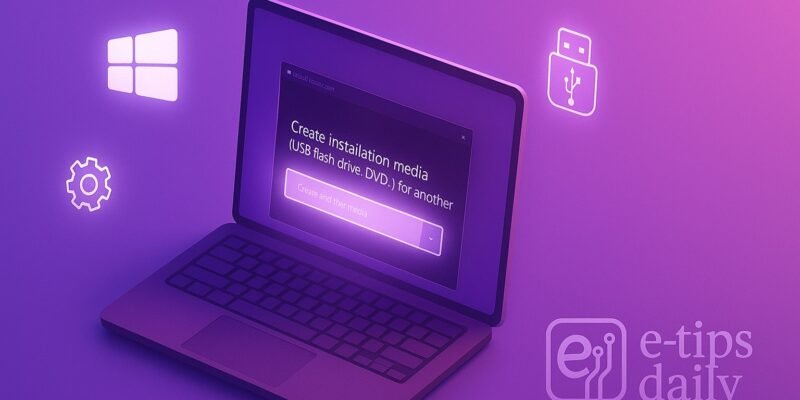Creating a bootable USB installer for Windows lets you install or repair Windows on any PC—even those without an optical drive. Whether you’re setting up a fresh system, troubleshooting a malfunctioning PC, or upgrading to the latest Windows version, a USB installer is your go-to tool.
In this guide, you’ll learn how to prepare your USB drive, download the official Windows ISO, and use both Microsoft’s Media Creation Tool and a popular third-party utility (Rufus) to make your bootable installer. You’ll also pick up pro tips, an advanced customization use case, and solutions to common pitfalls.
By the end, you’ll have a portable Windows installer ready to go—no DVDs required. Let’s dive in!
Step-by-Step Guide
- Gather Your Materials
- A USB flash drive (8 GB or larger).
- A Windows PC with Internet access.
- Administrative privileges on that PC.
- Download the Windows Media Creation Tool
- Go to the official Microsoft download page.
- Click Download tool now under “Create Windows 10/11 installation media.”
- Save and run the
.exeas an administrator.
- Run the Media Creation Tool
- Accept the license terms.
- Select Create installation media (USB flash drive, DVD, or ISO file) and click Next.
- Choose language, edition, and architecture (64-bit is typical).
- Prepare Your USB Drive
- Insert your USB drive.
- In the tool, select USB flash drive and click Next.
- Choose your USB from the list (double-check you’ve selected the correct drive, as it will be formatted).
- Click Next—the tool will download Windows and write it to the USB.
- Verify the USB Installer
- After completion, eject and re-insert the USB.
- You should see files like
boot,sources, andsetup.exe. - If missing, rerun the tool or switch to an alternative method below.
- Alternative: Create with Rufus
- Download Rufus from rufus.ie.
- Insert your USB drive and launch Rufus.
- Under Boot selection, click SELECT and choose your downloaded Windows ISO.
- Leave Partition scheme at MBR (for BIOS) or GPT (for UEFI).
- Click START—Rufus will format and make your USB bootable.
- Configure Your PC to Boot from USB
- Restart the target PC and enter BIOS/UEFI (usually F2, F10, F12, DEL).
- Set the USB device as the first boot option.
- Save changes and exit—your PC should boot into Windows Setup.
Pro Tips & Workflow Improvements
- Use USB 3.0 ports and drives for faster write/read speeds.
- Verify ISO checksum (SHA-1/SHA-256) against Microsoft’s published values to ensure file integrity.
- Label your USB (e.g.,
WIN11_INSTALLER) to avoid confusion if you have multiple drives. - Keep drivers handy: slipstream critical drivers (e.g., storage controllers) into the
\sources\boot.wimfor smoother installs on older hardware. - Use Windows To Go mode in Rufus for a fully portable Windows environment.
Advanced Use Case: Unattended Install
Want a hands-free setup? Create an autounattend.xml file to automate partitioning, license key entry, and user creation:
- In the root of your USB, add
autounattend.xmlconfigured with your preferences. - On boot, Windows Setup will read this file and apply your custom settings automatically.
- Great for deploying multiple systems without manual intervention.
Resources: Microsoft’s Unattended Windows Setup Reference (look up specific XML tags for version details).
Troubleshooting & Common Mistakes
| Issue | Solution |
|---|---|
| USB not recognized in BIOS | Try a different port (USB 2.0 vs. 3.0), update your motherboard’s firmware, or use another USB drive. |
| “Windows cannot be installed” error | Ensure partition scheme matches BIOS mode (UEFI→GPT, Legacy BIOS→MBR). Reformat as necessary using Disk Management or during Setup. |
| ISO too large for FAT32 | Use NTFS format in Rufus (UEFI-NTFS boot stub) or split the install.wim into smaller .swmfiles with DISM. |
| Slow USB write speed | Switch to USB 3.1 drive/port, or use a high-quality brand (SanDisk Extreme, Samsung BAR Plus). |
| Corrupted download | Re-download the ISO or retry Media Creation Tool; check your network and use a wired connection if possible. |
Conclusion
You’ve now mastered creating a bootable USB installer for Windows—ideal for fresh installs, repairs, and upgrades. Practice these steps to build reliable installation media every time.
Next up: explore “How to Deploy Windows with MDT” or “Slipstreaming Drivers into a Windows Image” to further streamline your deployment workflow. Good luck, and happy installing!

